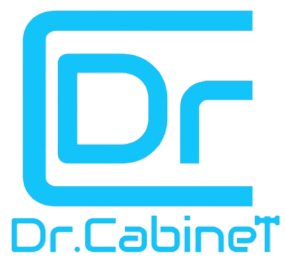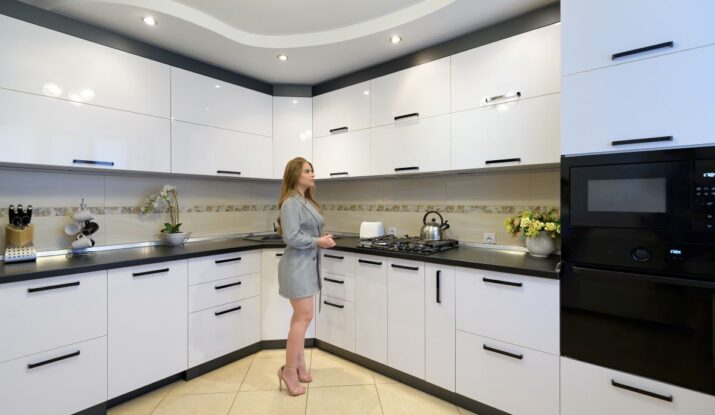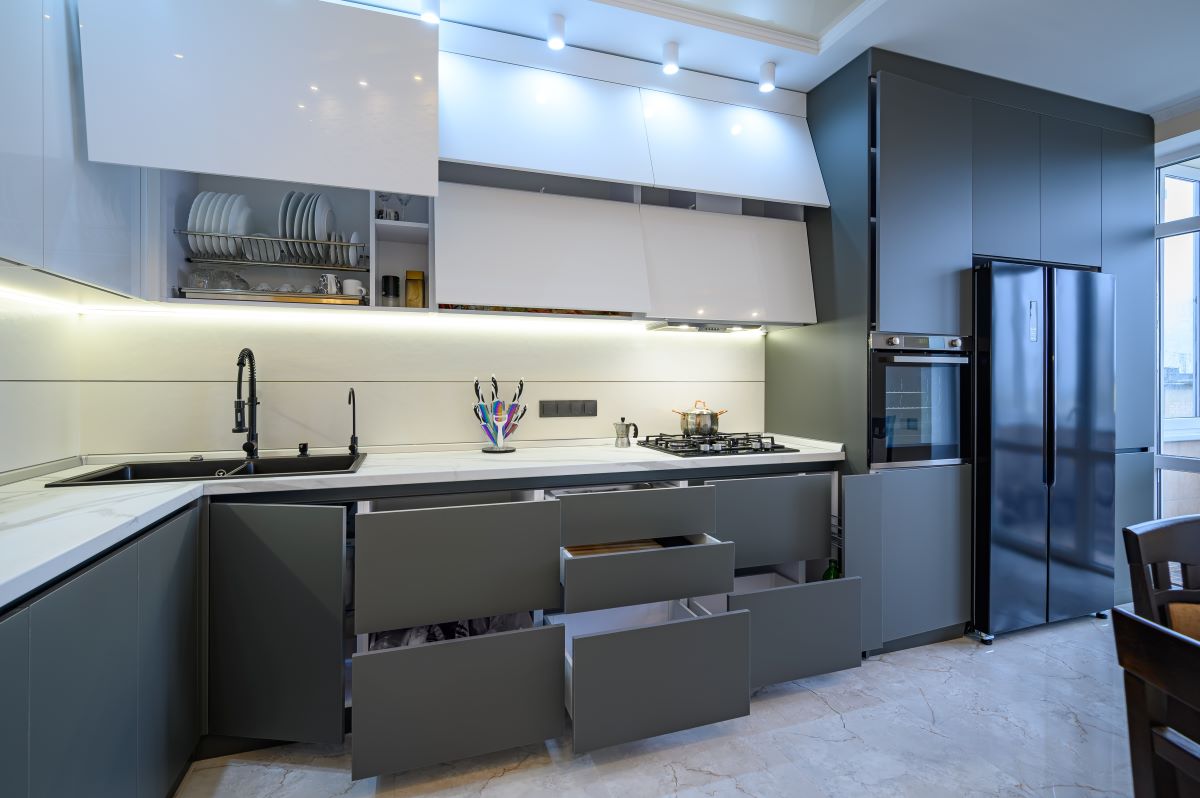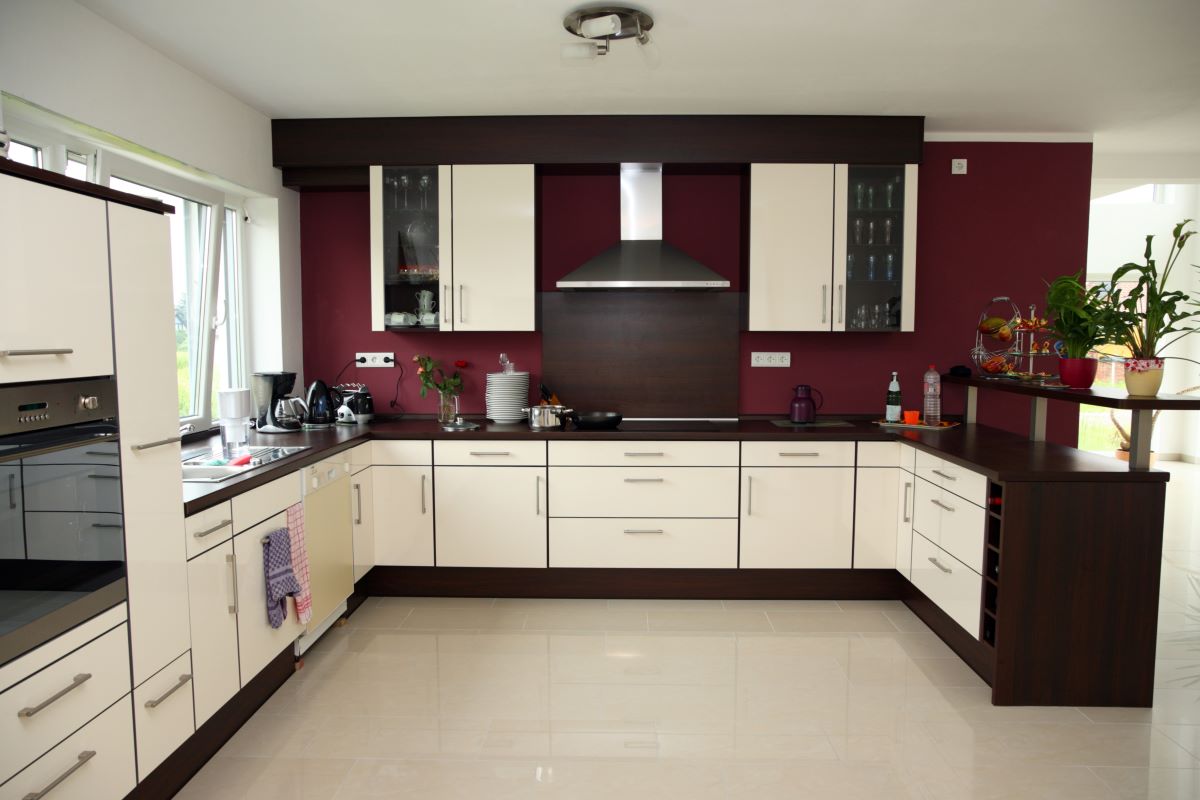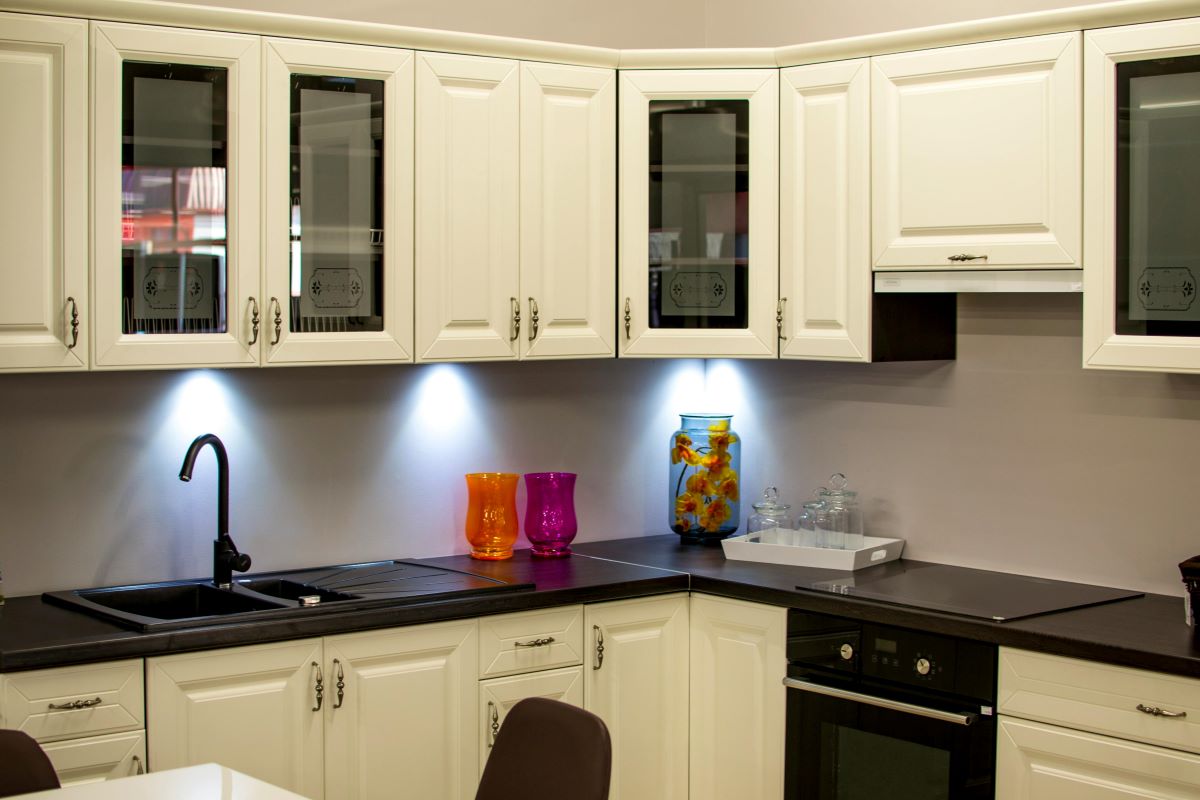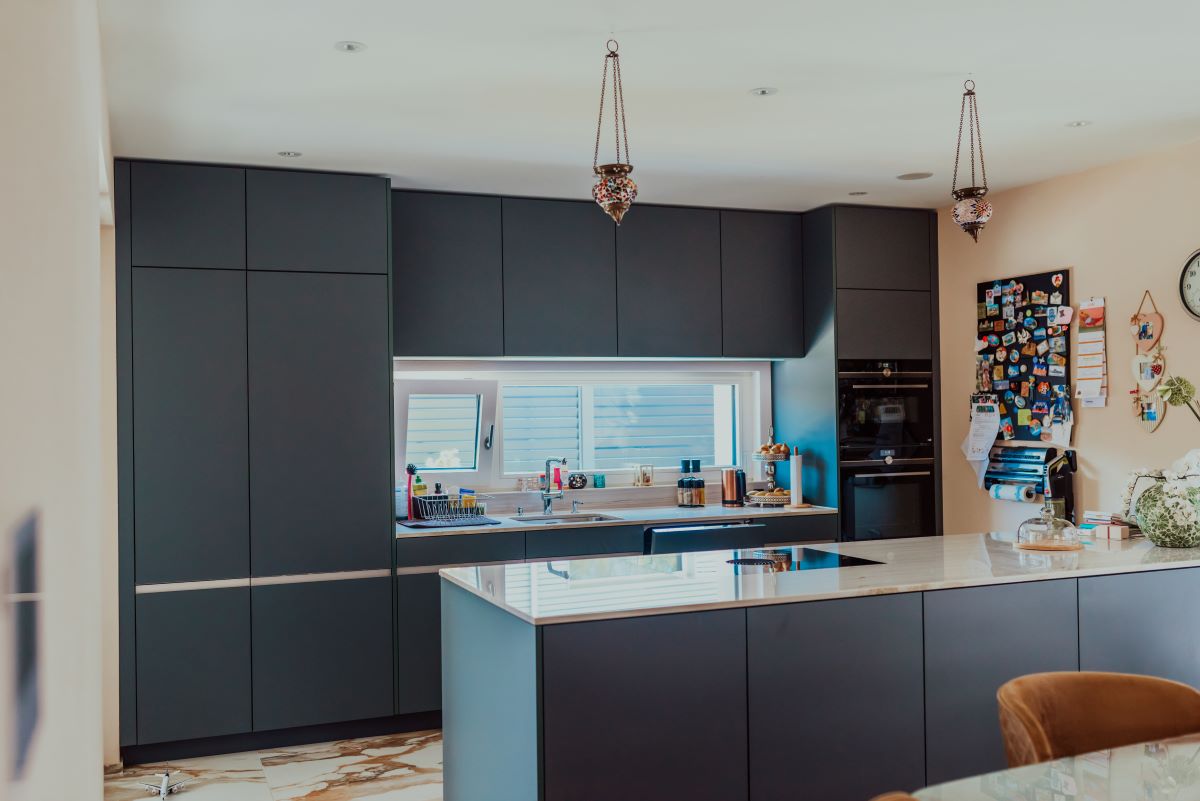Adding new cabinets to existing kitchen cabinets is a smart and affordable way to increase your storage without starting from scratch
In this post, we’ll guide you through where you should put in the cabinets, how to match them to your current arrangement, and some common faux pas to avoid. You will also get design tips, cost breakdowns and whether to DIY or hire a pro. If your kitchen has always felt cramped or chaotic, it’s easier than you might think to create space more easily.
Why adding new cabinets to your existing ones
Replacing an entire set of kitchen cabinets costs thousands—and disrupts your life for weeks.
But when you already have existing cabinets in decent shape, why not work with what’s there?
Here’s why many homeowners go for cabinet additions instead:
- It’s budget-friendly
- It avoids demolition
- You can customize for your current needs
- It improves your kitchen storage fast
This trend? It’s not just smart – it’s got style, saves time, and even helps the planet.
Check Your Current Kitchen Before Adding Cabinets
Hold up! Before you get swept away by those dreamy cabinets, ask yourself:
- Are your current cabinets holding up okay?
- Does your existing kitchen have structural damage or moisture issues?
- Do your current cabinet doors match what’s available now?
Check for gaps, wonky doors, or loose hinges—these little things can mess with where cabinets fit or how seamless they look.
Where to Add Cabinets Without a Full Kitchen Remodel?
This is where things get fun.”
Seriously, even in a tiny kitchen, there’s usually way more empty wall space and ignored corners than you’d think. If you’re wondering, can you move kitchen cabinets to create room in those underused corners. The answer depends on how your current cabinetry is installed.
Best spots to add cabinets:
- Above upper cabinets to reach the ceiling height
- Along empty wall space next to windows or pantries
- Beneath existing countertops
- Around the fridge cabinet zone
- Overhead, near the sink or backsplash
A skilled custom cabinet maker can use these spaces to create hidden or open storage—whatever fits your kitchen style.
Upper Cabinets vs Lower Cabinets – What to Add Where?
There’s a big difference between upper cabinets and lower cabinets, and knowing which to install matters.
| Type | Best Use Cases | Pro Tip |
| Upper Cabinets | Good for light items, dishes, glass fronts | Go tall—taller upper cabinets = more storage |
| Lower Cabinets | Better for heavy cookware, pantry pull-outs | Install drawers for easier access |
Want more counter space? Extending base cabinets or perimeter cabinets gives you both surface and storage. Adding new cabinets to existing kitchen cabinets in the right layout—like upper for display or lower for function—can balance aesthetics with practicality.
Transforming Wall Space with Built-Ins and Open Shelving
Sometimes, built-ins are the hero of your kitchen upgrade.
- Built-ins match your existing cabinetry
- Ideal for a coffee bar, spice rack, or open dish display
- Can feature open shelving or enclosed cabinet doors
On the flip side, open shelves offer a trendy, airy look.
Just keep in mind: they require regular organizing and dusting.
Corner Cabinets: The Most Wasted Space You’re Not Using
If you’ve ever reached into a dark, deep corner cabinet, you know it’s tricky.
That’s where smart solutions come in:
- Lazy Susans
- Diagonal corner cabinets
- Pull-out corner cabinets
- Kidney-shaped trays
These options just add more cabinets—no need to replace what you already have. Plus, they’ll give you storage space you didn’t even realize was possible.
How to Match New Cabinets with Original Cabinets
Stressing about your new cabinets looking out of place?
They don’t need to match perfectly—just flow together naturally.
Here’s how to match new and old cabinets:
- Reuse existing doors as templates
- Use similar wood tones or complementary white paint
- Pick a coordinating door style and hardware
- Update all cabinet faces with new doors for consistency
Sometimes, updating just the old doors can make everything feel fresh—especially if your original cabinets have good bones.
Boost Storage With a Kitchen Island Addition
A kitchen island doesn’t just give you more counter space—it’s prime real estate for storage.
Add:
- Deep drawers for pots
- Pull-out trash or recycling bins
- Open shelves for cookbooks
- A wine rack or snack station
Even a new island in a small kitchen can improve flow, prep space, and organization. If you’re short on perimeter space, adding new cabinets to existing kitchen cabinets via a central island is an excellent way to boost storage creatively.
Don’t Forget the Sink Area – Add Cabinets or Drawers There Too
Most kitchens waste space under the sink.
But with proper waterproofing and custom fit-outs, you can add cabinets or drawers even there.
Options include:
- Pull-out trays
- Sliding bins
- Tilt-out sponge holders
- U-shaped cabinetry to fit plumbing
Just make sure it’s moisture-resistant to protect the cabinets from leaks.
Kitchen Cabinet Additions: Mistakes to Skip
Steer clear of these blunders that waste your time, cash, and sanity:
- Picking a color that just doesn’t work
- Adding upper cabinets that don’t align with existing countertops
- Forgetting about counter space needs
- Ignoring cabinetry depth
- Skipping measurements of wall space, ceiling, and floor level
Real-Life Example: How One NYC Family Transformed Their Kitchen
Dr. Cabinet worked with a Brooklyn family with an outdated existing kitchen.
Instead of gutting it, they:
- Installed new cabinetry over existing cabinets
- Matched the old cabinets using stained wood
- Added a custom kitchen island for more counter space
- Integrated built-ins around the fridge cabinet and microwave
Result? 40% more storage space and a modern, polished kitchen—without a full kitchen remodel.
Choosing Materials That Match Your Existing Cabinets
You’ve got your plan. Now for the real challenge – picking stuff that won’t clash with what you’ve already got.
Here’s what to consider:
- Wood grain & color: Stick close to your cabinet’s original tones.
- Finish: Want glossy, matte, or that worn-in distressed look? Consistency creates flow
- Paint: A fresh coat of white paint can refresh your entire space
- Hardware: Handles and knobs matter! Match styles, not just finishes
- Cabinet doors: Shaker, slab, inset—go for a style that fits the rest
Use contrast intentionally if your old cabinets can’t be matched . Put white cabinets above and stained cabinets below create a balanced, modern aesthetic.
Cost to Add Cabinets vs. a Full Remodel?
Let’s compare so you don’t overspend:
| Renovation Option | Average Cost (2025) | Timeline | Best For |
| Adding New Cabinets to Existing Ones | $2,500 – $7,000 | 1–3 days | Homeowners wanting quick upgrades |
| Full Kitchen Remodel | $20,000 – $60,000 | 3–6 weeks | Outdated or damaged kitchens |
| Cabinet Refacing | $4,000 – $10,000 | 2–5 days | Structurally sound cabinets needing a look refresh |
| DIY Additions | $500 – $3,000 | Varies | Handy homeowners adding small sections |
If your existing cabinetry is in good shape, add additional cabinets. It is the most cost-effective path to a functional and stylish kitchen.
Add Cabinets Around Appliances for More Storage
Ever notice the empty open space around your oven or fridge?
That’s prime real estate for new cabinetry, especially in a small kitchen.
Options include:
- Upper cabinets above the fridge
- Side pantry units
- Built-in microwave hutch
- Slide-out spice racks right next to the oven, so handy
Small tweaks like this save space and just… make cooking easier.
Upper Cabinet Hacks – Go Tall, Go Smart
Maximize vertical wall space by installing taller upper cabinets.
You’ll get:
- Extra rows of storage for seasonal or rarely used items
- A finished, floor-to-ceiling look
- Cleaner lines that make the kitchen feel taller
Pair tall cabinets with a sturdy step ladder and voila—you’ve gained a new level (literally) of storage space.
Lower Cabinet Add-Ons That Pack a Punch
If your lower cabinets don’t meet your needs anymore, consider:
- Pull-out drawers in base cabinets
- Soft-close doors
- Roll-out trays for heavy pots
- Trash/recycling drawers
- Toe-kick drawers (yes, in that little strip under your cabinets!)
These upgrades pop right into your existing cabinets. Your countertops stay untouched.
Integrating Built-Ins for a Seamless Look
Want that ‘custom-designed kitchen’ look without the hassle?
Yeah, that’s what built-ins do. A custom cabinet maker can create smart storage solutions in awkward gaps or bare wall space.
Ideas include:
- Coffee or beverage stations
- Pull-out pantry columns
- Drop zones for keys, mail, and tech
- Charging drawers or hidden outlets
Try to pick built-ins that either match or go well with your current cabinets.
Open Shelving vs. Closed Cabinets
Open shelving has become very popular in recent years. It is good for many reason.
Pros:
- Airy feel
- Easy to access everyday items
- Great for decorative styling
Cons:
- Requires regular tidying
- Limited protection from dust or grease
Love the style but need it to work better? Try combining open shelves with a few glass-door cabinets up top
Working With Your Current Countertops and Fixtures
You might be asking yourself: “Wait… can I actually get new cabinets without ripping out my old countertops and backsplash?”
Totally doable! In most situations, your existing countertops won’t even need to budge.
Here’s how:
- Add upper cabinets or open shelves above your counters
- Install bottom cabinets to extend an island
- Use freestanding units along bare wall space
Hiring a pro means everything runs smoothly. No messing up your pipes or wiring.
DIY vs. Professional Cabinet Additions – Which One’s Right?
If you’re handy, you may be tempted to do this solo.
But know this—cabinetry is about more than just hanging boxes.
Here’s a quick comparison:
| Factor | DIY | Professional (e.g., Dr. Cabinet) |
| Cost | Lower upfront | Investment, but long-term quality |
| Custom Fit | Limited by tools/skill | Perfectly fitted to your existing kitchen |
| Finish Matching | Harder to get right | Seamless blend with original cabinets |
| Installation Time | Weekends or evenings | Quick and precise |
| Results | Varies | Guaranteed, clean, and professional |
Bottom line? Unless it’s a small job, hiring an expert like Dr. Cabinet saves you time, stress, and costly do-overs.
Create a Kitchen That Works for You
Adding new cabinets to existing kitchen cabinets isn’t just a trend—it’s a smart way to get the kitchen you want without starting over.
By using:
- Unused wall space
- Above-appliance areas
- Hidden zones like toe-kicks and corners
- A fresh kitchen island
- Quality built-ins or open shelving
You’ll gain tons of storage, free up space for how you live, and even boost your home’s worth—no kitchen demolition needed.
Ready to Add Cabinets Without the Stress?
Let’s make your kitchen work smarter – not harder.
Schedule a free consultation with Dr. Cabinet today.
We’ll help you design, match, and install new storage that looks like it’s always been there.
FAQs
Can I add cabinets without a full kitchen remodel?
Yes. If your existing cabinetry is in good shape, you can easily add cabinets to boost kitchen storage without a full remodeling job.
How do I match new cabinets to my old ones?
Use similar paint, wood, door style, and hardware. Or update all cabinet faces with new doors for a consistent look.
Is a kitchen island worth adding in a small kitchen?
Yes - especially if it includes drawers and cabinets. Mobile or narrow island units can offer huge storage space gains without overwhelming the room.
How much open space do I need to add new cabinets?
You can use even 12 inches of wall or corner space. A custom cabinet maker can turn awkward gaps into functional storage.
